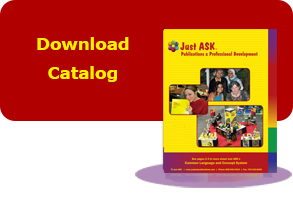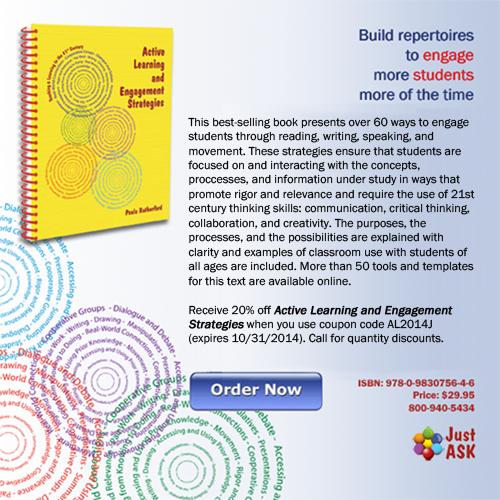
Volume XI Issue IX
Share this newsletter on
Moving to 21st Century Thinking Skills

Bruce facilitating a Leading the Learning® workshop
New descriptors of more rigorous teaching and learning practices are found in 21st century learning standards. Words such as collaborate, elaborate, hypothesize, prove/argue, symbolize and transform are appearing more and more. These words require a different approach to planning teaching and learning experiences.
In past decades, many classrooms were more teacher-centered. Instruction included the transmission of subject content, facts, dates, formulas, research findings, theories, stories and general information. Today’s students can find all this knowledge and much more with the click of a mouse. Equally important in todays fast-paced world is the necessity of providing experiences for our students which will help them develop a wide range of skills which they can apply to their future education settings as well as in their chosen professions beyond school. As a result, the role of teachers must change from sharing personal wisdom to promoting thinking among their charges.
Transitioning to new ways to delivering instruction requires determination, effort, and deliberate action. Neil Armstrong spoke of “small steps” and “giant leaps “when he set foot on the moon. The former rather than the latter should apply to any new classroom behavior on the part of a teacher. The question then becomes: What does a classroom look like when a teacher creates an environment where students are challenged to become deep thinkers?
Teaching our students to think must be one of our highest priorities. Our students may very well forget the factual information we have provided for them, but teaching students to think more deeply is a life-long skill that transcends the content and will stick with them for the rest of their lives. They may not shower us with tangible gifts but in their minds they will respect us, thank us, and value the time they spent with us. Always remember, it’s the thought that counts.
Paula Rutherford in her book, Instruction for All Students, presented a chart entitled Yesterday and Today…Where We’ve Been & Where We Are Going. Building on Paula’s idea, I have created a similar chart to provide guidance as we work to establish a more thought-provoking classroom.
Yesterday & Today…
Moving to 21st Century Thinking Skills
|
Emphasis was on memorization of facts. |
Emphasis is on evidence-based responses and the development of skills. |
|
|
Teacher was the primary source of information. |
Students use a wide variety of sources. |
|
| Any source of written information was considered valid. | Students are expected to evaluate the reliability of sources. | |
|
Emphasis was on finding, remembering, listing, describing, explaining, and naming. |
Students are challenged to invent, create, justify, critique, deconstruct, interrogate, assess, and convince. | |
|
Students were expected to supply the right answer. |
Students are asked to explain the thinking behind their answers. | |
|
Teacher questions focused more on what and when. |
Questioning requires students to respond to why and how. | |
| Primary classroom tools were textbooks, chalkboards, and paper and pencils. | Tools include paper and pencils plus digital devices, interactive technology, and human resources. | |
| Students sat in straight rows, focused on the teacher, and talking was limited. | Students are involved in social learning using applications such as Zoom, Google Classrooms, Flipgrid, Nearpod, and Microsoft Teams. | |
| Teachers often planned their lessons, based on teacher’s manuals and program guides. | Standards and authentic performance-based tasks drive instructional planning. | |
| Teachers had limited resources for planning engaging lessons. | Teachers now have access to online resources like Khan Academy, The Teaching Channel, Edutopia, and Newsela. | |
| Students worked more independently and projects were mostly completed outside of class. | Students interact in Socratic Seminars, Reciprocal Teaching, and Project-Based Learning (PBL), etc. | |
|
Whole-class instruction with all students using the same resources was often the norm. |
The use of scaffolding and parallel texts ensures all students can tackle complex concepts and do rigorous thinking. |
|
| In class, students listened to teacher lectures and took notes, watched demonstrations, and, then, completed homework outside of class. | In flipped classrooms, input of information occurs outside of class and classtime is devoted to interactive group learning. | |
| Homework was often preparation (read a chapter) and practice (complete a worksheet). | Homework is often extension or creative and requires application of new learning. | |
| The primary audience for student work was the teacher’s inbox. | Students design products for a variety of audiences, including classmates. | |
| Students often focused on four C’s: Capture the lecture, Color code the notes, Cram for the test, and Cross your fingers that you can remember the facts. | Students are assessed on the four C’s of the 21st Century Skills: Communication, Collaboration, Critical Thinking, and Creativity and Innovation. | |
| Assessment of learning was completed primarily by the teacher. | Students are asked to self-assess to determine and set learning goals. | |
| Students often worked in Levels 1 and 2 of Webb’s Depth of Knowledge (DOK). | Students are asked to complete more tasks at Levels 3 and 4 of DOK. | |
| In Daggett’s Rigor and Relevance Framework®, students operated almost exclusively in Quadrants A and B. | Students move quickly through Quadrants A and B and delve more thoroughly into Quadrants C and D. | |
| Students learning was measured primarily with paper and pencil assessments. | Student learning is measured in multiple ways, including paper and pencil assessments. | |
| Students received a grade on assessment and the next learning segment was introduced no matter the level of mastery. |
Students are provided growth-producing feedback and are expected to react to that feedback in ways that promote further learning.
|
|
Resources and ReferencesClayton, Heather. “Creating Classroom Cultures for Thinking.” Making the Standards Come Alive! ______________. “The Thinking Behind the Content: Standards for Mathematical Practice.” Making the Standards Come Alive! Daggett, Willard. Rigor/Relevance Framework® :A Guide to Focusing Resources to Increase Student Performance. Kay, Ken. The Four C’s: Making 21st Century Education Happen Lee, J.F., Jr., and Pruitt, K.W. “Homework Assignments: Classroom Games or Teaching Tools?” Clearing House, 1979, 53 (1): 31-35. Rutherford, Paula. Active Learning and Engagement Strategies. Alexandria, VA: Just ASK Publications and Professional Development, 2012. _______________ . Instruction for All Students. Alexandria, VA: Just ASK Publications & Professional Development, 2012. 50 Education Technology Tools Every Teacher Should Know About, Levels of Thinking in Bloom’s Taxonomy and Webb’s Depth of Knowledge |
Permission is granted for reprinting and distribution of this newsletter for non-commercial use only. Please include the following citation on all copies:
Oliver, Bruce. “Moving to 21st Century Thinking Skills.” Just for the ASKing! September 2014. Reproduced with permission of Just ASK Publications & Professional Development (Just ASK). © 2014 Just ASK. All rights reserved. Available at www.justaskpublications.com.




